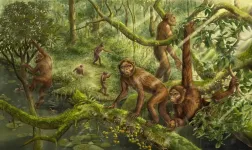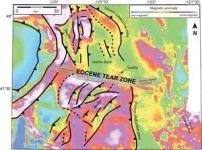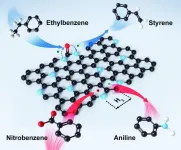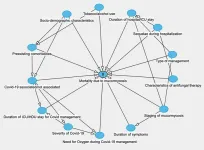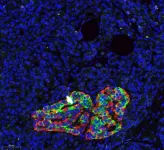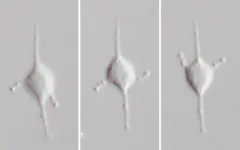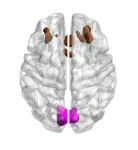(Press-News.org) A new study of a 7–8-million-year-old extinct fossil ape from China called Lufengpithecus offers new insights into the evolution of human bipedalism.
The study, published in The Innovation, was conducted by a team from the Institute of Vertebrate Paleontology and Paleoanthropology (IVPP) of the Chinese Academy of Sciences, the Yunnan Institute of Cultural Relics and Archaeology (YICRA), and New York University (NYU).
Humans and our closest relatives, the living apes, display a remarkable diversity of locomotor abilities, from walking upright on two legs to climbing and clambering in trees to walking using all four limbs. Scientists have long been fascinated by the question of how our unique bipedal stance and movement evolved from a quadrupedal (walking on four limbs) ancestor. However, earlier studies of the diverse locomotor repertoires of living apes, as well as evidence from their fossil record, did not allow the reconstruction of a definitive history of the evolution of human bipedalism.
Most studies of the evolution of ape locomotion have focused on the bones of the limbs, shoulders, pelvis, and spine (the postcranial skeleton) and their linkages to the range of locomotor behaviors seen in living apes and humans. In contrast, the researchers in this study used a novel approach that focused on studying the inner ear.
"The semicircular canals, located in the skull between our brain and the external ear, are critical for our sense of balance and position when we move, and they provide a fundamental component of our locomotion that most people are probably unaware of. The size and shape of the semicircular canals have mathematical correlation with how mammals, including apes and humans, move around their environment. Using modern imaging techniques, we are able to visualize the internal structure of fossil skulls and study the anatomical details of the semicircular canals to reveal how extinct mammals moved," said ZHANG Yinan, first author of the study and an IVPP Ph.D. student.
Lufengpithecus was slightly smaller than a chimpanzee and lived during the Miocene Epoch between 6.2 and 12.5 million years ago in what is now Yunnan Province in southwestern China. Lufengpithecus is known from various parts of its skeleton, including several skulls collected by paleontologists at IVPP and YICRA. Severe compression and distortion of these skulls obscured the bony ear region, however, leading previous researchers to believe that the delicate semicircular canals were not preserved.
"When we scanned the skulls with our state-of-the-art 3D multiscaling and multimodal imaging system at the IVPP we were quite surprised to see the inner ear and its bony semicircular canals. We used high-resolution digital data to create an accurate virtual reconstruction of the delicate structures of the bony canals. We then compared these scans with those of other living and fossil apes and humans from Asia, Europe, and Africa. Our analyses show that early apes shared a locomotor repertoire that was ancestral to human bipedalism," said Prof. NI Xijun of IVPP, project leader and corresponding author of the study.
Using the evolutionary tree of apes to analyze and compare the size and shape of the semicircular canals and related features of the inner ear, the researchers identified several key nodes in the evolutionary history of ape locomotion. The locomotor behavior of most fossil apes and their reconstructed ancestral states do not resemble living apes. This means that extinct apes did not move exactly like living apes and humans, and the postcranial skeletons of living apes may not provide the best analogs for reconstructing the locomotion of extinct species.
Later, the human lineage diverged from the great apes with the acquisition of bipedalism, as seen in Australopithecus, an early human relative from Africa. The international team also proposed that cooler global temperatures, beginning ~3.2 million years ago, may have been an important environmental catalyst in promoting the locomotor diversification of apes and humans.
"Our study points to a three-step evolution of human bipedalism. First, the earliest apes moved in the trees in a style that was most similar to aspects of the way that gibbons in Asia do today. Second, the last common ancestor of apes and humans was similar in its locomotor repertoire to Lufengpithecus, using a combination of climbing and clambering, forelimb suspension, bipedalism, and quadrupedalism. It is from this broad ancestral locomotor repertoire that human bipedalism evolved," said co-author Prof. Terry Harrison of NYU.
The remarkable diversity of locomotor patterns found in fossil apes and their living relatives was an important aspect of their success for millions of years in Eurasia and Africa. A specialized lineage of African apes later developed a unique mode of bipedal locomotion that eventually led to humans.
END
Inner ear of miocene fossil ape gives clues to evolution of bipedalism
2024-02-06
ELSE PRESS RELEASES FROM THIS DATE:
GPT-3 transforms chemical research
2024-02-06
Artificial intelligence is growing into a pivotal tool in chemical research, offering novel methods to tackle complex challenges that traditional approaches struggle with. One subtype of artificial intelligence that has seen increasing use in chemistry is machine learning, which uses algorithms and statistical models to make decisions based on data and perform tasks that it has not been explicitly programmed for.
However, to make reliable predictions, machine learning also demands large amounts of data, which isn’t always available in chemical research. Small chemical datasets simply do not provide enough information for these algorithms to train on, which limits their effectiveness.
In ...
Guanine synthesis yields new insights into nitrogen’s role in nanocarbon catalysis
2024-02-06
In recent years, carbon-based catalysts — especially nitrogen-doped nanocarbons — have emerged as sustainable, reliable alternatives to the metal catalysts that have traditionally been used to support chemical reactions. Researchers from the Key Laboratory of Advanced Carbon-Based Functional Materials (Fujian Province University) at Fuzhou University synthesized nanocarbons from guanine molecules to better understand the precise role nitrogen plays in the carbon-based materials and explore the reaction mechanisms of these catalytic systems.
In a recently published study, the research team clarified how different types of nitrogen can modulate oxidative dehydrogenation ...
Baseline findings among hospitalized mucormycosis patients —— A multicentric ambispective cohort study in India
2024-02-06
Mucormycosis is a relatively rare but serious fungal infection increasingly recognised for its poor prognosis and high mortality. Due to the COVID-19 pandemic, the incidence of mucormycosis reached high levels during 2021–2022 in India.
This study led by Dr. Rizwan Suliankatchi Abdulkader (Indian Council of Medical Research) established a multicentric ambispective cohort of patients hospitalised with mucormycosis across India and reported their baseline profile, clinical characteristics, and outcomes at discharge.
Mucormycosis was diagnosed based on mycological confirmation on direct microscopy (KOH/Calcofluor white stain), ...
New DNA methylation-based method for precise assessment of pancreas cell composition
2024-02-06
Research introduces new DNA methylation-based method for accurately assessing cell composition in the human pancreas, addressing a critical gap in diabetes research. By overcoming limitations of traditional protein marker-based approaches, the study provides a more precise means to identify specific cell types. The findings offer insights into beta-cell dysfunction across diabetes types and have direct clinical implications, enhancing our understanding of diabetes development and potentially guiding more tailored treatment ...
Remarkable cellular architecture and phylogenetic position of the mysterious arm-swinging protist meteora sporadica
2024-02-06
Tsukuba, Japan—Meteora sporadica is a small, unicellular eukaryote (protist) that was discovered in deep Mediterranean sea sediments in 2002. It differs from known protists by the presence of two lateral arms that swing back and forth. However, the ultrastructure and phylogenetic position of M. sporadica remain unknown.
In this study, researchers successfully cultured and analyzed two strains of M. sporadica from marine sediments in detail. Ultratructural observations revealed ...
Mechanism of plants obtain nitrogen by supplying iron to symbiotic bacteria
2024-02-06
Tsukuba, Japan—Leguminous plants have a mechanism (rhizobial symbiosis) to efficiently acquire nitrogen, which is an essential macronutrient for growth, through the nitrogen-fixing bacteria rhizobia. Root nodules are organs on plant roots that facilitate the symbiotic relationship. Rhizobia coloniza these nodules and fix nitrogen by converting nitrogen from air into ammonia. Iron is needed for the enzymes that catalyze nitrogen fixation; however, where and how iron is transported to the nodule and used for nitrogen fixation is largely unknown.
In this study, using the legume model plant Lotus japonicus, a transcriptome ...
11 leading stroke scientists to receive American Stroke Association honors
2024-02-06
PHOENIX, Feb. 6, 2024 – Eleven scientists leading the way in stroke research will be recognized during the American Stroke Association’s International Stroke Conference 2024 for their exceptional professional achievements. The meeting will be held in Phoenix, Feb. 7-9, and is a world premier meeting for researchers and clinicians dedicated to the science of stroke and brain health.
The illustrious group of awardees includes four groundbreaking scientists who have devoted their careers to stroke research and six scientists will be recognized for their notable new research. The awards include the Ralph L. Sacco Outstanding Stroke Research ...
Powerful answers to energy questions may be blowing in the wind
2024-02-06
While wind farms have become a widely popular method of generating energy, researchers are now looking at the impact of these large farms on wind patterns and the surrounding environment.
Using large-scale simulations to better understand the way air moves across and within wind farms, researchers from UBC Okanagan and Delft University of Technology (TU Delft) in the Netherlands have developed a modelling framework that will help improve wind energy forecasts and productivity.
The researchers also hope to learn how large wind farms can alter natural wind patterns.
“Wind farms are getting so large that ...
Discover BMB announces exciting lineup of speakers
2024-02-06
Be front and center for the hottest research findings in the molecular life sciences at Discover BMB, the annual meeting of the American Society for Biochemistry and Molecular Biology, to be held March 23–26 in San Antonio.
Don’t miss this opportunity to hear from the top minds in the field. Reporters are invited to register for a complimentary press pass to attend #DiscoverBMB in San Antonio or access press materials electronically. Please note that only a limited number of complementary on-site press passes will be issued, so advance registration is recommended. Find more information in the #DiscoverBMB newsroom.
As part of an exciting program spotlighting the ...
Study finds strongest evidence to date of brain’s ability to compensate for age-related cognitive decline
2024-02-06
Scientists have found the strongest evidence yet that our brains can compensate for age-related deterioration by recruiting other areas to help with brain function and maintain cognitive performance.
As we age, our brain gradually atrophies, losing nerve cells and connections and this can lead to a decline in brain function. It’s not fully understood why some people appear to maintain better brain function than others, and how we can protect ourselves from cognitive decline.
A widely accepted notion is that some people’s brains are able to compensate ...
